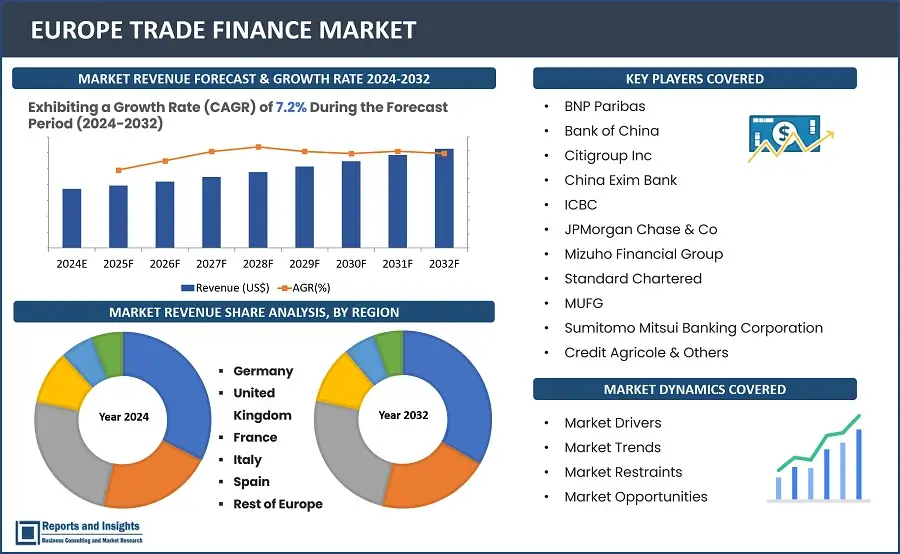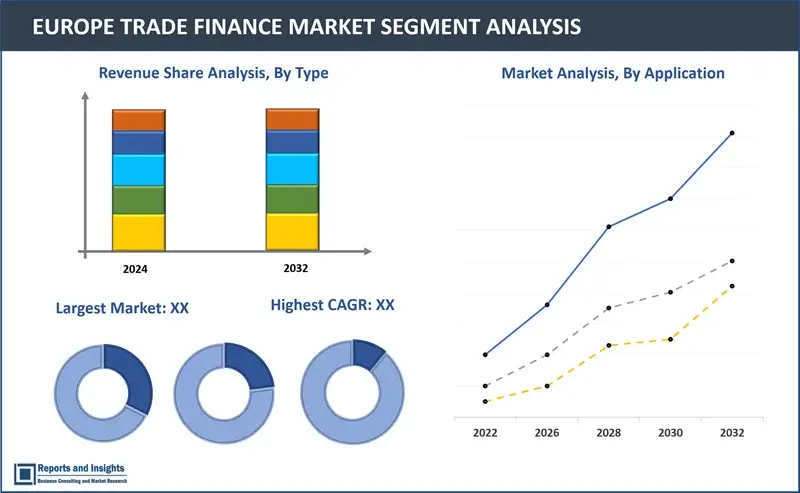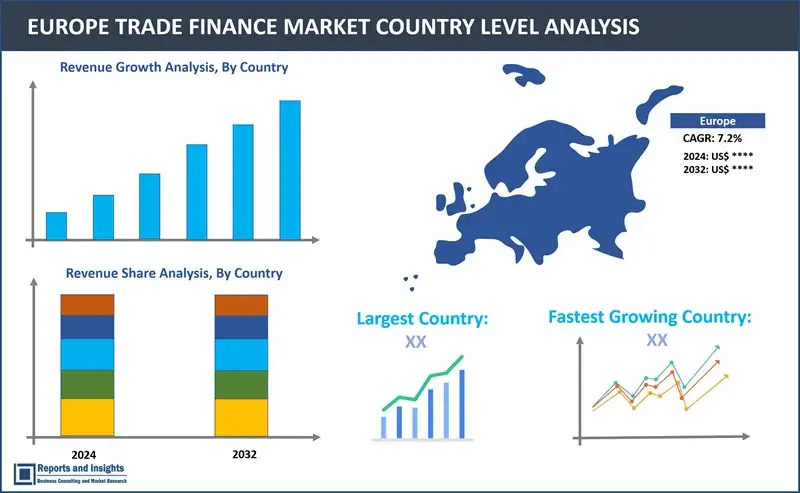Market Outlook:
"According to Reports and Insights analysis, the Europe trade finance market is expected to register a revenue CAGR of 7.2% during the forecast period. Europe trade finance refers to the financial mechanisms and services designed to streamline international trade activities within the European continent."
|
Report Attributes |
Details |
|
Base Year |
2023 |
|
Forecast Years |
2024-2032 |
|
Historical Years |
2021-2023 |
|
Market Growth Rate (2024-2032) |
7.2% |
Market Overview:
Trade finance involves the offering of capital, assurances, and risk management solutions by financial entities to facilitate the exchange of goods and services between European enterprises and their global counterparts. The spectrum of trade finance instruments in Europe includes items like letters of credit, trade credit insurance, and documentary collections, all aimed at reducing the financial uncertainties linked to cross-border trade and fostering the seamless movement of goods and services across European boundaries.
The trade finance market in Europe is a dynamic and resilient sector crucial to facilitating international trade across the continent. Distinguished by a variety of financial instruments and services such as letters of credit, trade credit insurance, and export financing, this market caters to the diverse needs of businesses involved in cross-border trade. Supported by a sophisticated infrastructure and a network of financial institutions, Europe's trade finance market ensures the seamless movement of goods and services by managing risks, improving liquidity, and offering financial solutions that empower businesses to participate in global commerce. The ongoing influence of technological advancements is reshaping the financial landscape, bringing about digital innovations that further streamline processes and enhance efficiency in international trade transactions.

Europe Trade Finance Market Trends and Drivers
The Europe trade finance market is witnessing notable trends and drivers, with a discernible move towards digitalization and sustainability. Advanced technologies like blockchain and artificial intelligence are being increasingly integrated, leading to streamlined processes and a reduction in paperwork. Notably, there is a growing emphasis on incorporating environmental, social, and governance (ESG) criteria into trade finance practices, aligning with sustainable principles. The market is becoming more inclusive, as alternative financing options and fintech solutions cater to the needs of smaller businesses. Geopolitical factors and regulatory shifts are additional influential factors shaping trade dynamics and financial strategies in the region. In essence, the Europe trade finance landscape is evolving in response to technological advancements, sustainability considerations, and the changing economic environment.
Europe trade finance market growth is influenced by several factors which include the integration of digital solutions such as blockchain and artificial intelligence, are pivotal contributors, enhancing operational efficiency and simplifying processes. Another significant factor is the increasing focus on sustainability within the market, as financial institutions incorporate environmental, social, and governance (ESG) considerations into their trade finance strategies, aligning with global trends towards responsible business practices. The market's inclusivity is expanding, driven by the growing prominence of alternative financing options and the widespread adoption of fintech solutions, particularly benefiting smaller enterprises. Additionally, geopolitical dynamics and regulatory frameworks play a crucial role, influencing trade patterns and financial strategies within the Europe trade finance landscape. In essence, the market's growth is a result of the interplay between technological innovation, sustainability priorities, inclusivity measures, and the broader geopolitical and regulatory context.
Europe Trade Finance Market Restraining Factors
Despite experiencing overall growth, the Europe trade finance market contends with various restraining factors that impede its advancement. Notably, ongoing geopolitical uncertainties, encompassing trade tensions and policy fluctuations, contribute to an unpredictable environment for businesses involved in cross-border transactions. Additionally, regulatory intricacies and compliance demands present challenges, resulting in heightened operational costs and potential trade process delays. Economic downturns, as witnessed during global crises, pose constraints on the market, limiting businesses' access to credit and fostering risk aversion. Moreover, the persistence of paper-based processes in certain European regions inhibits the industry's complete embrace of digital transformation, hindering potential efficiency improvements. Effectively addressing these diverse challenges is crucial for unlocking the full potential of the Europe trade finance market.
Europe Trade Finance Market Opportunities
The Europe trade finance market is brimming with opportunities for growth and innovation. The increasing embrace of digital technologies, such as blockchain and artificial intelligence, provides avenues to enhance efficiency and streamline operations. With sustainability taking center stage, the integration of environmental, social, and governance (ESG) considerations into trade finance practices opens up possibilities for responsible and ethical financing solutions. Additionally, the growing demand for inclusive financing options and the proliferation of fintech solutions create opportunities for financial institutions to meet the needs of smaller businesses, promoting financial inclusivity. By capitalizing on these trends and proactively adapting to evolving regulatory frameworks, the Europe trade finance market is poised for ongoing expansion and transformation.
Europe Trade Finance Market Segmentation

By Finance Type
- Structured Trade Finance
- Supply Chain Finance
- Traditional Trade Finance
The Europe trade finance market is segmented by finance type, comprising structured trade finance, supply chain finance, and traditional trade finance, each serving distinct roles in facilitating global trade. Structured trade finance involves tailored financial solutions, often utilizing complex instruments like letters of credit and guarantees, to support substantial and high-value transactions. Supply chain finance, on the other hand, focuses on optimizing cash flow within the supply chain by providing financing options to both suppliers and buyers, thereby improving liquidity and operational efficiency. Traditional trade finance encompasses well-established instruments such as letters of credit and documentary collections, offering a more conventional approach to supporting international trade. This categorization reflects the diverse needs of businesses engaged in cross-border transactions, offering them a range of financial tools and services to manage risks, boost liquidity, and ensure smooth and secure trade operations within the European market.
By Offering
- Letters of Credit
- Bill of Lading
- Export Factoring
- Insurance
- Others
The Europe trade finance market is categorized by offering, which includes letters of credit, bill of lading, export factoring, insurance, and various other services, each fulfilling a specific role in facilitating global trade. Letters of credit provide a secure payment mechanism, ensuring contractual obligations are met for both buyers and sellers. A bill of lading serves as a crucial document, acting as a receipt for shipped goods and a proof of ownership. Export factoring involves the sale of accounts receivable to a financial institution, offering exporters immediate cash flow. Insurance services play a key role in risk mitigation for trade transactions, providing coverage against potential losses. The "Others" category encompasses additional specialized financial instruments and services that contribute to the diverse landscape of trade finance, meeting the varied needs of businesses engaged in cross-border transactions in the European market.
By Service Provider
- Banks
- Trade Finance Houses
The Europe trade finance market is categorized based on service providers, primarily consisting of banks and trade finance houses, each playing a crucial role in facilitating global trade. Banks, being traditional financial institutions, serve as key providers of a wide range of trade finance services, including letters of credit, financing, and risk management. In contrast, trade finance houses specialize in delivering customized solutions tailored to the specific requirements of businesses involved in cross-border transactions. These entities work synergistically in the market, with banks offering comprehensive financial services and trade finance houses contributing specialized expertise. This collaboration ensures the efficient and secure movement of goods and services across borders, enhancing the overall effectiveness of trade operations in the European landscape.
By End User
- Small
- Medium Sized Enterprise (SMEs)
- Large Enterprises
The Europe trade finance market is categorized by end users, serving the unique needs of small enterprises, medium-sized enterprises (SMEs), and large enterprises involved in global trade. Small enterprises benefit from tailored trade finance solutions that address their specific financial challenges, facilitating their engagement in cross-border transactions. Medium-sized enterprises, dealing with intricate supply chain dynamics, utilize trade finance to optimize working capital and improve liquidity. Large enterprises, managing substantial trade volumes, rely on trade finance instruments to mitigate risks and ensure the seamless execution of extensive international transactions. This segmentation underscores the market's flexibility in meeting the distinct requirements of businesses of different sizes, contributing to the overall effectiveness and efficiency of cross-border trade operations in the European context.
By Country

- Germany
- United Kingdom
- France
- Italy
- Spain
- Russia
- Poland
- Benelux
- Nordic
- Rest of Europe
The Europe trade finance market is categorized by country, including influential nations like Germany, the United Kingdom, France, Italy, Spain, Russia, Poland, Benelux, Nordic countries, and the rest of Europe. Each country adds a distinct flavor to the trade finance landscape, with unique economic dynamics, trade patterns, and financial structures. Germany, being a major economic force, holds a pivotal role in steering trade finance activities, while the United Kingdom's status as a global financial hub further enhances its importance. France, Italy, Spain, and other European nations contribute to the overall richness of trade finance operations, each grappling with specific challenges and capitalizing on unique opportunities. The Benelux countries and the Nordic region, known for their robust economic performances, also significantly influence the trade finance scene. The rest of Europe comprises additional nations that contribute to the overall complexity and diversity of cross-border trade operations. This regional breakdown underscores the intricate and varied nature of the Europe trade finance market, reflecting the economic diversity and trade intricacies present throughout the continent.
Leading Europe Trade Finance Providers & Competitive Landscape:
The Europe trade finance market is highly competitive, with several key players vying for market share and actively engaging in strategic initiatives. These companies focus on innovation, technological advancements, and expanding their product portfolios to gain a competitive edge. These companies are continuously investing in research and development activities to enhance their product offerings and cater to the evolving needs of customers in terms of efficiency, performance, and sustainability.
These companies include:
- BNP Paribas
- Bank of China
- Citigroup Inc
- China Exim Bank
- ICBC
- JPMorgan Chase & Co
- Mizuho Financial Group
- Standard Chartered
- MUFG
- Sumitomo Mitsui Banking Corporation
- Credit Agricole
- Commerzbank
- HSBC
- Riyad Bank
- Saudi British Bank
- ANZ
- EBRD
- Japan Exim Bank
- Banque Saudi Fransi
- Afreximbank
- AlAhli Bank
- Export-Import Bank of India
Europe Trade Finance Market Research Scope
|
Report Metric |
Report Details |
|
Market size available for the years |
2021-2023 |
|
Base Year |
2023 |
|
Forecast Period |
2024-2032 |
|
Compound Annual Growth Rate (CAGR) |
7.2% |
|
Segment covered |
Finance type, offering, service provider, end-user, and countries. |
|
Countries Covered |
Germany, United Kingdom, France, Italy, Spain, Russia, Poland, Benelux, Nordic, Rest of Europe |
|
Fastest Growing Country in Europe |
Germany |
|
Key Players |
BNP Paribas, Bank of China, Citigroup Inc, China Exim Bank, ICBC, JPMorgan Chase & Co, Mizuho Financial Group, Standard Chartered, MUFG, Sumitomo Mitsui Banking Corporation, Credit Agricole, Commerzbank, HSBC, Riyad Bank, Saudi British Bank, ANZ, EBRD, Japan Exim Bank, Banque Saudi Fransi, Afreximbank, AlAhli Bank and Export-Import Bank of India. |
Frequently Asked Question
At what CAGR will the Europe trade finance market expand?
The market is anticipated to rise at 7.2% CAGR through 2032.
What are some key factors driving revenue growth of the Europe trade finance market?
Some key factors driving market revenue growth include international trade volumes, supply chain finance, competitive landscape, and geopolitical stability.
What are some major challenges faced by companies in the Europe trade finance market?
Companies face challenges such as risk management, fraud and cybersecurity concerns, trade disputes and tariffs and lack of standardization.
How is the competitive landscape in the global Europe trade finance market?
The market is competitive, with key players focusing on technological advancements, product innovation, and strategic partnerships. Factors such as product quality, reliability, after-sales services, and customization capabilities play a significant role in determining competitiveness.
Which country has the biggest market share Europe trade finance market?
Germany has the biggest market share in Europe Trade Finance market.
How is the Europe trade finance market segmented?
The market is segmented based on by finance type, offering, service provider, end-user, and countries.
Who are the key players in the Europe trade finance market?
BNP Paribas, Bank of China, Citigroup Inc, China Exim Bank, ICBC, JPMorgan Chase & Co, Mizuho Financial Group, Standard Chartered, MUFG, Sumitomo Mitsui Banking Corporation, Credit Agricole, Commerzbank, HSBC, Riyad Bank, Saudi British Bank, ANZ, EBRD, Japan Exim Bank, Banque Saudi Fransi, Afreximbank, AlAhli Bank and Export-Import Bank of India.
Which countries and regions are covered in the report?
Germany, United Kingdom, France, Italy, Spain, Russia, Poland, Benelux, Nordic, and Rest of Europe.

